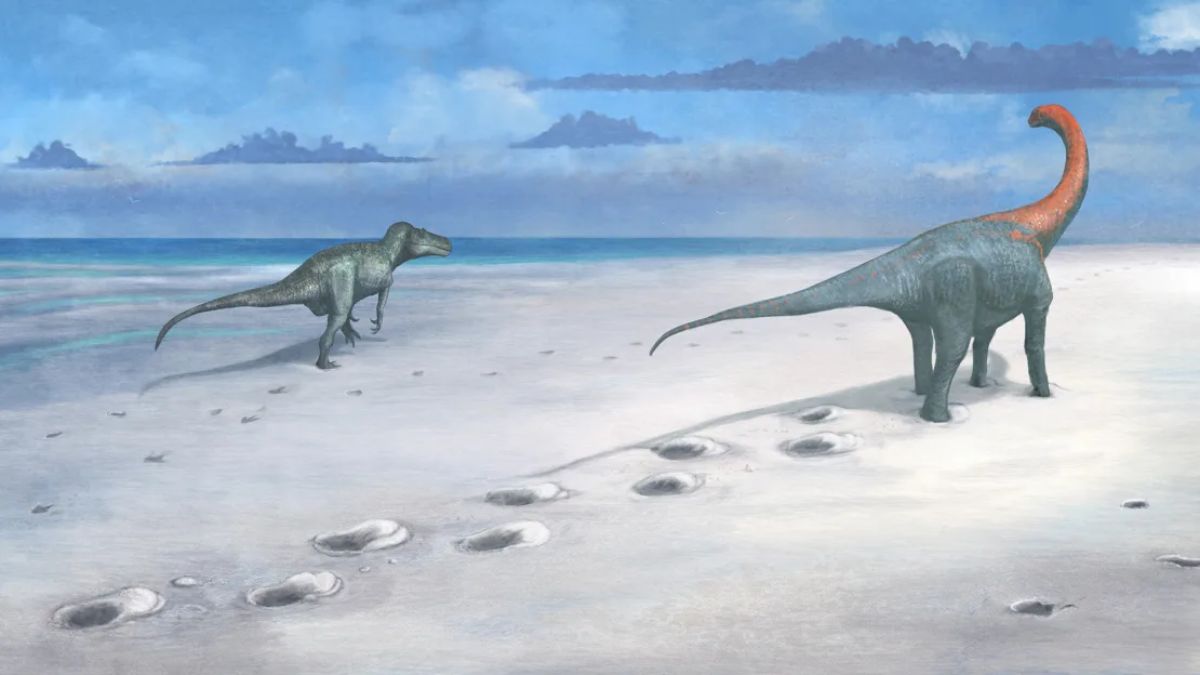It all began last June when a worker at a limestone quarry in southeast England came across some “unusual bumps” while digging up clay for road construction.
But what seemed like a minor curiosity turned out to be something extraordinary.
A team of over 100 researchers visited the site and upon excavation confirmed that these mysterious bumps were in fact dinosaur tracks, that dated back an incredible 166 million years to the Middle Jurassic period.
Dubbed the “dinosaur highway,” palaeontologists believe the nearly 200 footprints discovered across multiple trails could represent the largest known dinosaur track site in the United Kingdom.
Here’s everything we know about this fascinating dinosaur highway.
‘Extraordinary window into the lives of dinosaurs’
At Dewars Farm Quarry, researchers from the Universities of Oxford and Birmingham have uncovered five extensive trackways. This discovery revealed on Thursday, offered a fascinating glimpse into the lives of dinosaurs during the Middle Jurassic period.
Researchers said, four of these tracks were attributed to sauropods, gigantic, long-necked herbivorous dinosaurs, most likely of the Cetiosaurus species. These gentle giants, cousins of the Diplodocus, could grow up to 18 metres long.
Whereas the fifth trackway belonged to a ferocious 30-foot-long carnivorous theropod, the Megalosaurus, which is famous for its distinctive large three-toed feet with claws.
“Scientists have known about and been studying Megalosaurus for longer than any other dinosaur on Earth, and yet these recent discoveries prove there is still new evidence of these animals out there, waiting to be found,” said Emma Nicholls, a vertebrate palaeontologist at the Oxford Museum of Natural History in an NPR report.
Interestingly, one area of the excavation site also showed the Megalosaurus and sauropod tracks crossing paths, prompting researchers to question whether and how these species might have interacted.
“These footprints offer an extraordinary window into the lives of dinosaurs, revealing details about their movements, interactions, and the tropical environment they inhabited," Kirsty Edgar, professor of micropaleontology at the University of Birmingham, told PBS News.
What did scientists observe?
From the footprints, researchers were also able to gain valuable insights into the direction and speed at which the dinosaurs were moving. Most of the sauropods appeared to be heading northeast at an average speed of 5 kilometres per hour, similar to a human walking pace, Edgar told CNN.
Larger theropods like the Megalosaurus were unlikely capable of running, unlike their smaller theropod counterparts, which might have been able to sprint at higher speeds.
Paleoecologist Lawrence Tanner of Le Moyne College, who was involved in the study told the news outlet that the dinosaurs could have been travelling along the shoreline, possibly to navigate around obstacles or search for food.
“The size of the individual tracks and the area that they cover is just huge," Edgar told Live Science in an email. “I’m in awe that I’m standing exactly where some of the largest animals to have existed once stood, and I love trying to think about where they were going, and why."
Jurassic Oxfordshire was vastly different from today’s landscape. Instead of grasslands, the region resembled the humid Florida Keys, with lagoons and muddy swamps creating perfect conditions for preserving tracks.
“There is a little bit of moisture so the sediment will take and hold the track but not so much that it loses its definition entirely and collapses,” Edgar explained to PBS News. “And, it was rapidly covered up, e.g., by a storm or such, enabling it to be preserved before it was eroded away or destroyed by other animals.”
What’s next?
To preserve and study the site, researchers used drone photography to capture over 20,000 images of the footprints. These images will now help create detailed 3D models, allowing scientists to delve deeper into the biomechanics and interactions of the dinosaurs.
“We have these 3D models for the first time, which means that anyone, as soon as we publish them, will be able to see the site and (its) legacy,” Edgar said to CNN.
Still, a large portion of the site remains unexplored. Edgar believes these untouched areas could hold even more information about the diverse species that roamed Jurassic Oxfordshire.
Over the next year, researchers will analyse the data collected and prepare to share their findings with the world, further unlocking the secrets of this prehistoric ‘dinosaur highway.’
With input from agencies
)